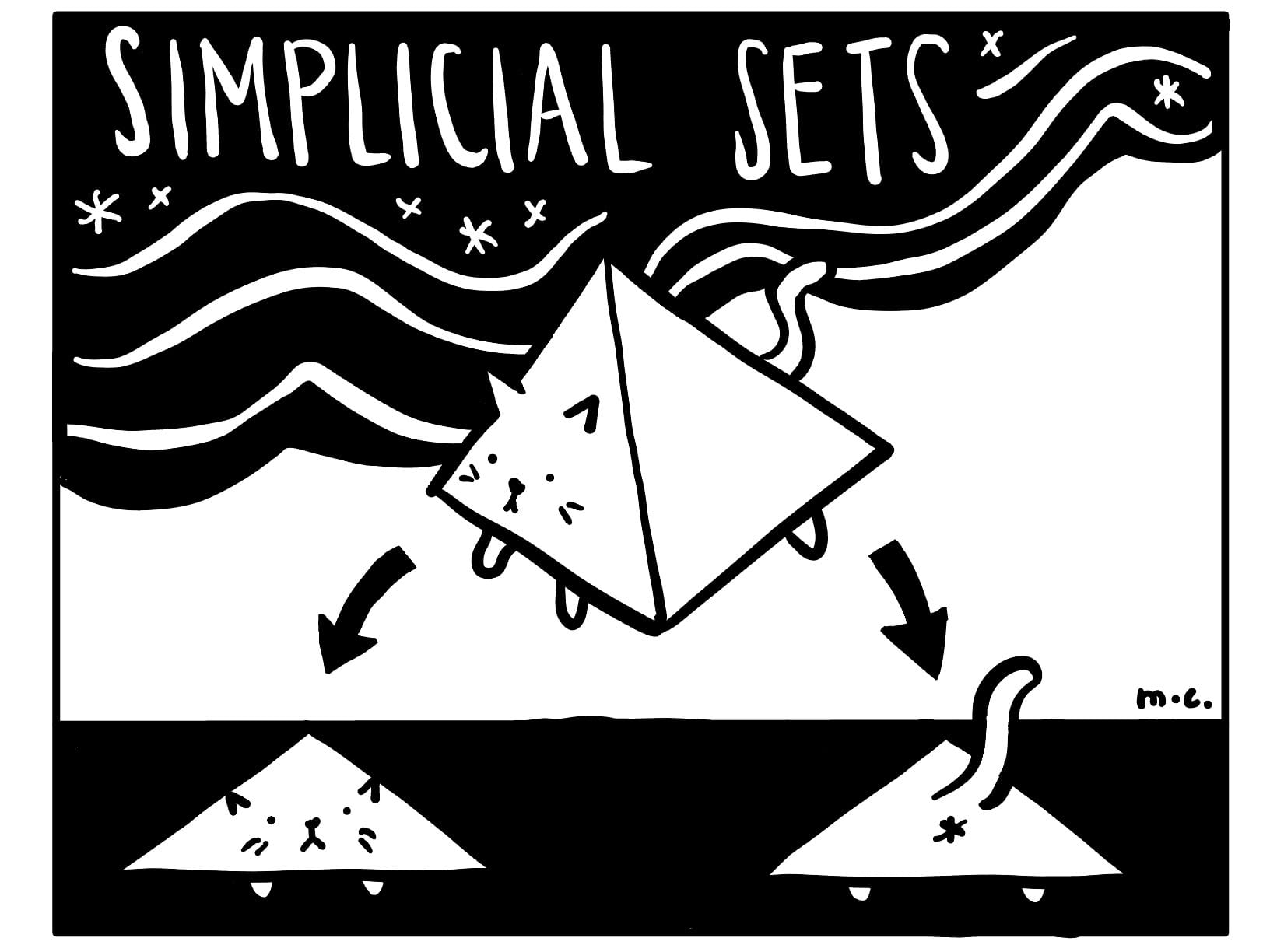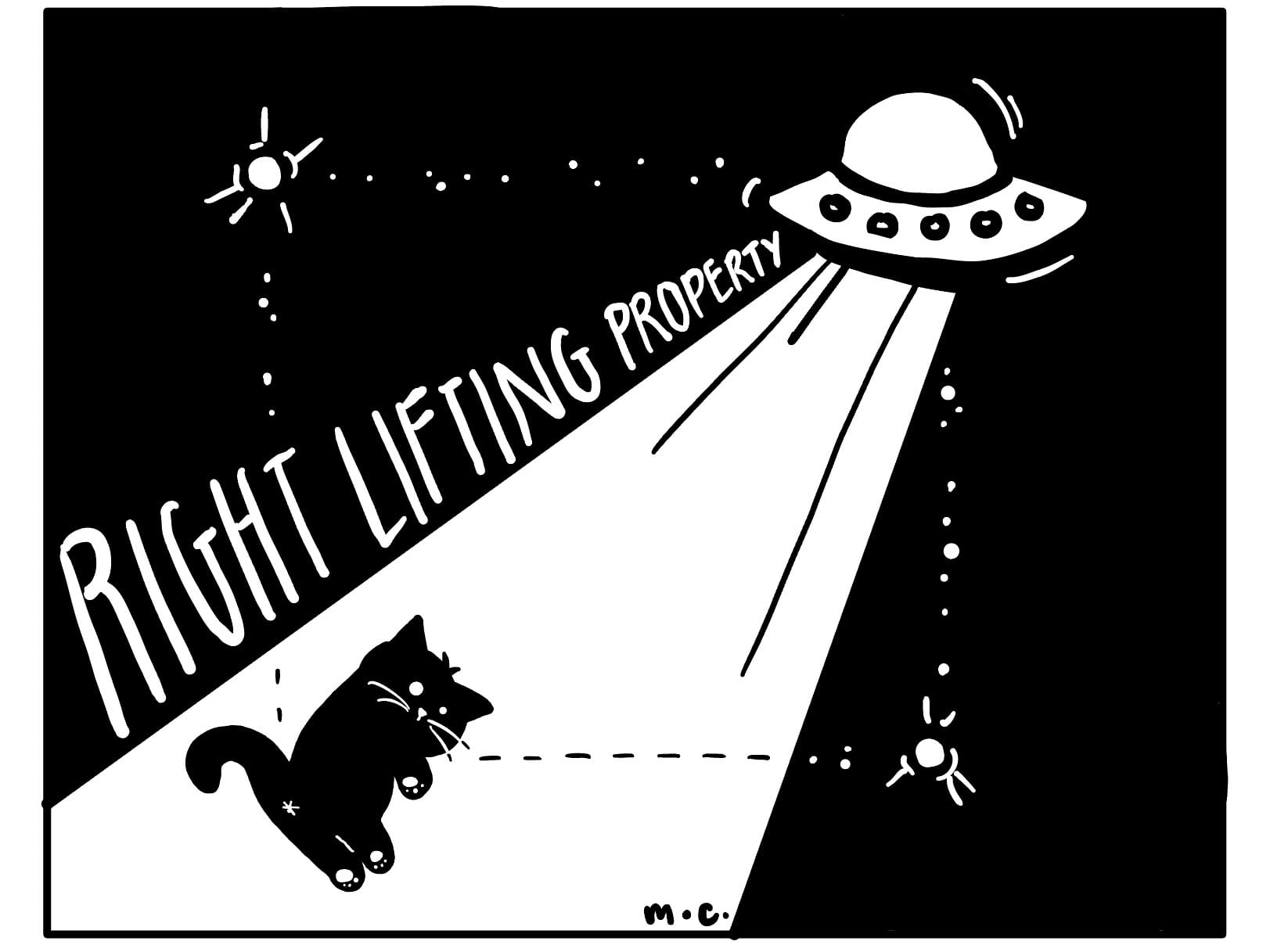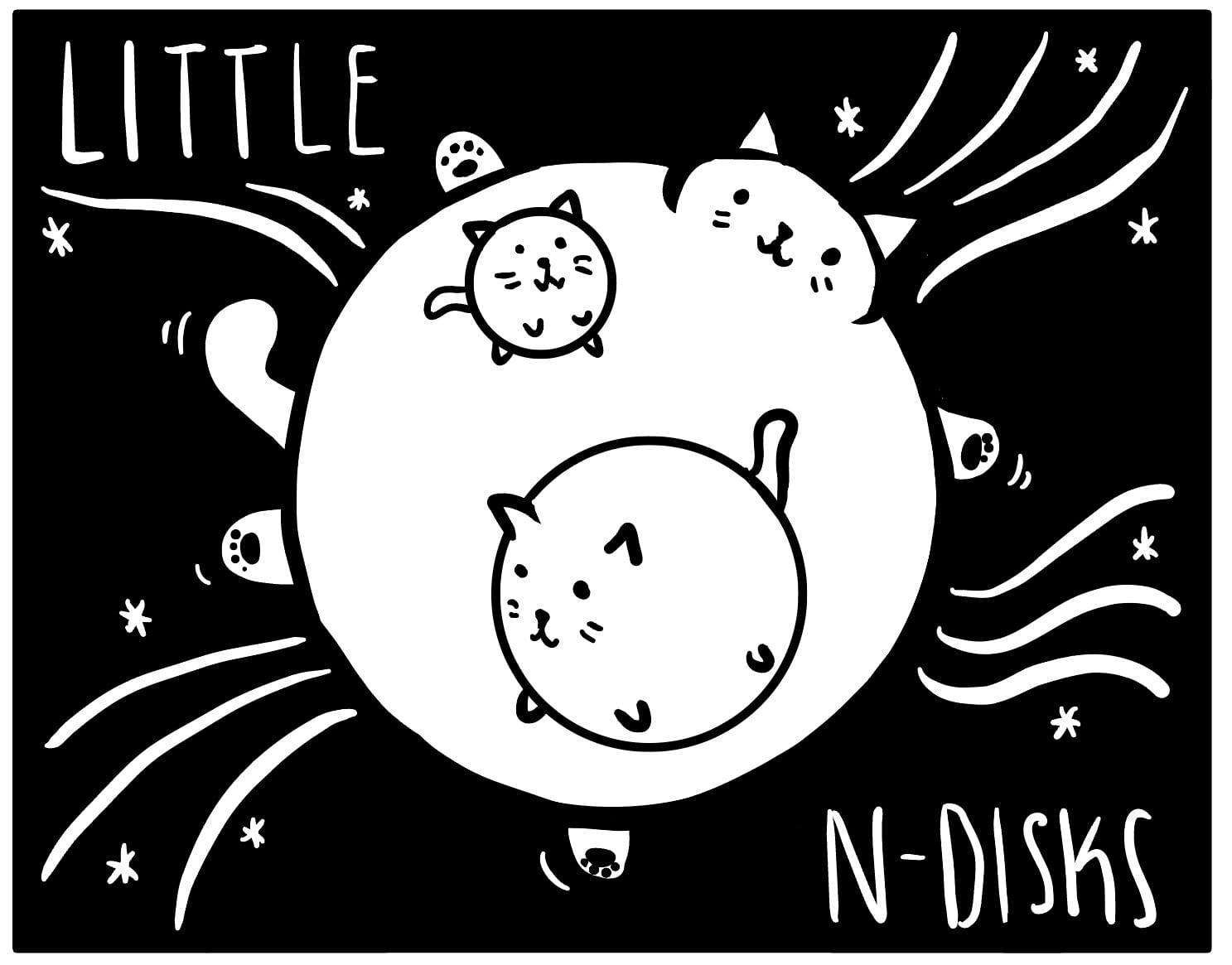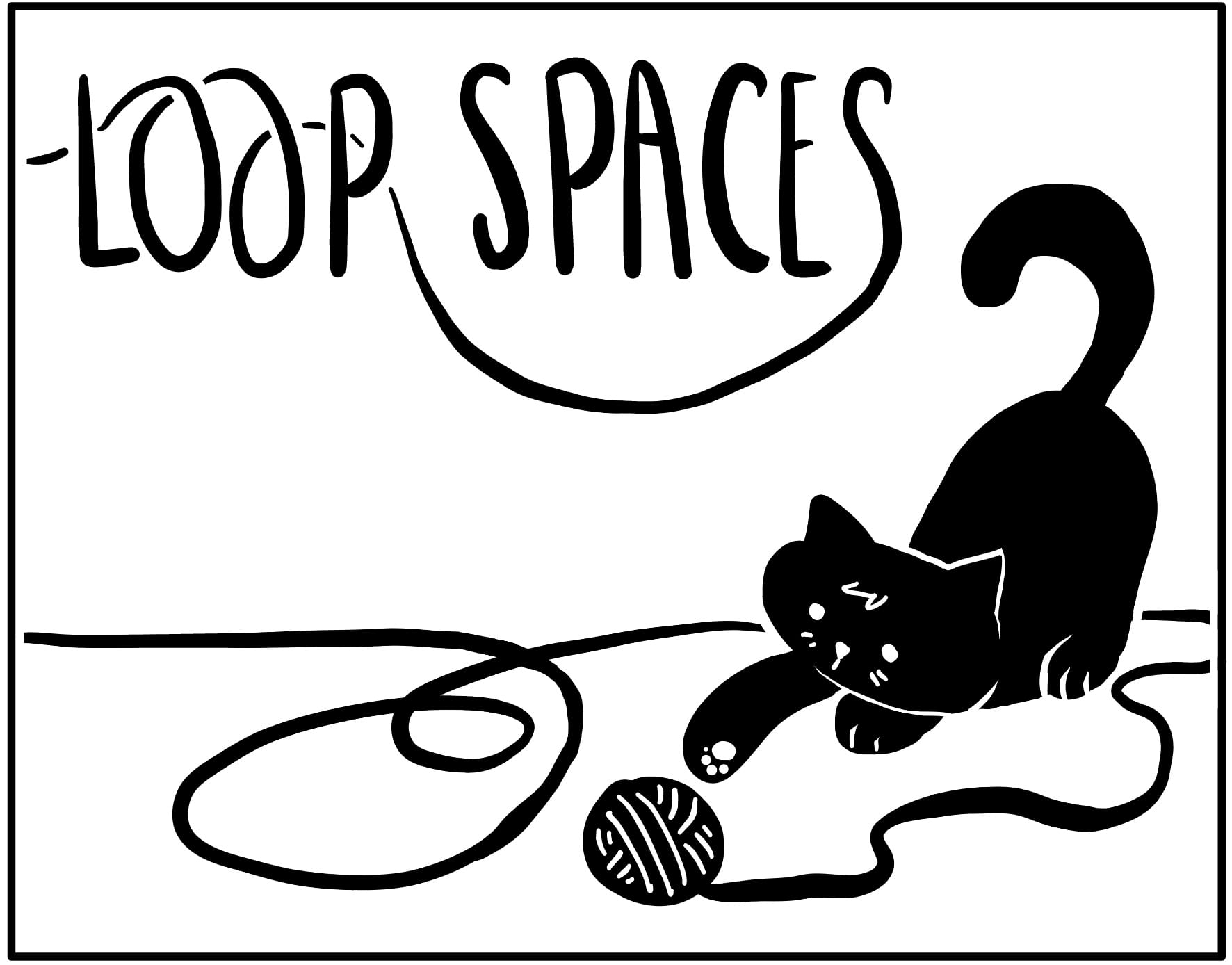I study algebraic topology, particularly homotopy theory, category theory, and K-theory, and the applications of these theories to manifolds. My favorite kinds of problems involve understanding topological/geometric structure using the tools of homotopy theory. Click below to learn more details.
My research is in an area of abstract math called algebraic topology, more specifically homotopy theory.
Topology is the study of shapes — both familiar shapes like circles and cubes, but also weird, higher-dimensional shapes that are hard to visualize (but here's one of my favorite attempts). I like to call topology the study of "squishy shapes" because, unlike in geometry, topologists don't care about rigid measurements like distance, angle or size. Two shapes are "topologically the same" if you can get from one to the other by squishing, stretching or otherwise deforming the shape without poking holes or making any tears. The classic joke is that a topologist can't tell the difference between their coffee mug and a donut.
So how can we tell if two shapes are "topologically the same" or not? This is a hard question that prompted the development of many different kinds of math, each with their own techniques and tools.
In algebraic topology, we create things that behave sort of like functions, in that they take inputs and assign them to outputs. I like to call these function-like-things "machines" instead of "functions" because oftentimes their construction is quite a bit more involved than something like f(x) = 2x+3. These machines take in squishy shapes as input and output something algebraic, like a number, a collection of numbers, a formula, or another abstract mathematical structure. We can then take these outputs and try to interpret them in a useful way to say something about the original shape. Maybe you could use the output to understand how DNA is knotted or to extract meaning from a large data set.
Rather than studying the outputs of these machines, I like to study the machines themselves and think about how to construct new ones. The framework I use to study these machines is called homotopy theory, which borrows a lot from a toolkit called category theory and combines intuition with a high degree of abstraction.
One type of machine that shows up a lot in my research is called K-theory, which records how things decompose into smaller pieces — much like molecules decompose into atoms. This simple idea has surprisingly powerful applications in a wide variety of fields of math; check out this article I wrote about how K-theory can be linked to a geometry problem from Ancient Greece.
I study algebraic topology, and I'm interested in how tools from homotopy theory and category theory can be applied to solve geometric/topological problems.
A lot of my research is in equivariant stable homotopy theory. The recent interest in this subfield of algebraic topology is in part due to Hill, Hopkins and Ravenel’s award-winning 2016 paper on the Kervaire invariant one problem. This long-standing problem has its roots in Milnor’s Fields Medal work on exotic smooth structures on spheres, and on the surface doesn’t appear to have anything to do with equivariant algebraic structures. Part of Hill, Hopkins and Ravenel’s strategy was to cleverly utilize equivariant stable techniques to solve this seemingly non-equivariant problem.
The starting place of equivariant homotopy theory is simple enough: Suppose I have a topological space X which comes with symmetries in the form of a (usually finite or compact Lie) group G. How can I adjust invariants from algebraic topology, like cohomology, to leverage these symmetries?
This natural question leads down a road full of new algebraic structures, the study of which is called equivariant algebra. In stable homotopy theory, we shift from studying things like rings and groups to studying their “homotopical” analogues, called spectra. Equivariant stable homotopy theory is the marriage of these two fields.
If algebraic topology machines take in a space and spit out something like a ring, then equivariant algebraic topology machines should take in an "equivariant space" and spit out something like an "equivariant ring." But there are many versions of rings in equivariant homotopy theory, each with a varying level of “genuineness.” Rings with G-action provide examples of equivariant rings, but they have a relatively low level of genuineness.
Equivariant rings can be studied much in the same way we study ordinary rings — we can ask about their ideals, modules or other algebraic structure. In a joint project with Sam Ginnett, we studied the prime ideals of a particular equivariant ring (called the Burnside Tambara functor) which plays the same role for equivariant rings as the integers does for ordinary rings.
Another focus of my research is algebraic K-theory, which is a powerful invariant of rings with connections to many different areas of mathematics including algebra, number theory, and geometric topology. In joint work with David Chan and Andres Mejia, we generalize algebraic K-theory to work for different kinds of equivariant rings. The output of our construction is a genuine G-spectrum, which is the central object of study in equivariant stable homotopy theory. In separate work, joint with Chan and Maximilien Péroux, we show that all G-spectra come from a similar equivariant algebraic K-theory construction, based on work of Bohmann–Osorno.
Although higher algebraic K-theory is classically defined to record information about rings, it can be expended to different settings where the objects can be "chopped up" in some algebraic way (e.g. via short exact sequences). One important example is Waldhausen's algebraic K-theory of spaces, which encodes geometric invariants about a given space. Building off work of Malkiewich–Merling, some of my work (joint with Chan and Mejia as well as Anish Chedalavada) studies equivariant analogues of well-known features of the algebraic K-theory of spaces.
A recent research program extends the definition of K-theory even further, where the object decompositions are combinatorial in nature rather than algebraic. This new "combinatorial K-theory" can be applied to study objects that did not previously fit into a K-theoretic framework. I'm interested in studying how K-theory can be used to say things about more combinatorial objects, such as graphs. Additionally, in an ongoing project with Liam Keenan and separately with Maru Sarazola, we investigate some fundamental theorems for these combinatorial K-theories and how they might be applied.
My research is in equivariant stable homotopy theory and categorical aspects of higher algebraic K-theory. I'm interested in how these tools can be applied to solve geometric/topological problems.
The primary objects of study in equivariant stable homotopy theory are genuine G-spectra. While there are several models for genuine G-spectra, a widely used framework is that of spectral Mackey functors, which has been formalized in the context of enriched category theory by Guillou–May and in ∞-categories by Barwick and coauthors Glasman–Shah. A spectral Mackey functor is roughly a collection of spectra, indexed on the subgroups of G, connected by structure maps called restrictions and transfers.
Just as the algebraic K-theory of a ring produces a spectrum, we would expect the equivariant algebraic K-theory of an "equivariant ring" to produce a genuine G-spectrum. Work of Merling provides such a K-theory construction for rings with G-action, and Brazelton explicates the spectral Mackey functor structure in certain cases. In joint work with David Chan and Andres Mejia, we construct an equivariant algebraic K-theory machine for coefficient systems of rings (which rings with G-action provide an example of), which contains Merling's output G-spectrum as a direct summand when comparable through Brazelton's work.
Our construction is suitably general to apply to other kinds of equivariant rings, such as Green functors, and is based on techniques that Malkiewich–Merling used to construct an equivariant refinement of Waldhausen's algebraic K-theory of spaces (aka A-theory). In fact, the primary goal of our construction was to provide a natural home for an equivariant version of the linearization map, which approximates the A-theory of a space X by the K-theory of the group ring ℤ[π1(X)]. The K-theory of ℤ[π1(X)] also encodes geometric invariants of X, such as Wall's finiteness obstruction and Whitehead torsion, and we show that our equivariant K-theory construction encodes the expected equivariant analogues of these invariants.
In ongoing work with Chan–Mejia, together with Anish Chedalavada, we study other equivariant analogues of well-known features of A-theory, such as the spherical group ring model and the splitting of the assembly map. Additionally, I'm interested in extending the definition of equivariant A-theory to orbispaces and studying the geometric invariants that are encoded by the resulting orbispectrum.
Equivariant K-theory constructions give us a way to produce genuine G-spectra, and in a joint project with Chan and Maximilien Péroux, we show that every G-spectrum arises (up to equivalence) this way, via a construction of Bohmann–Osorno.
However, multiplicative structures in equivariant stable homotopy theory are quite subtle and not yet fully understood. For instance, it is unknown whether equivariant A-theory is a genuine G-ring spectrum, as is true non-equivariantly. Tools for approaching these kinds of problems would come from the theory of equivariant operads, which is the subject of an ongoing project with Julie Bergner, David Chan, Andres Mejia, Angélica Osorno, and Maru Sarazola, building on joint work with Bergner–Bonventre–Chan–Sarazola.
Although genuine G-ring spectra are mysterious objects, their homotopy groups yield an important type of equivariant algebraic structure called a Tambara functor, which is like a Mackey functor but with extra structure maps called norms. For instance, the 0th stable equivariant homotopy group of the equivariant sphere spectrum is known as the Burnside Tambara functor and plays the same role for Tambara functors as the integers does for ordinary rings. It takes its name from the Burnside ring, which has its origins in representation theory and was studied extensively by Dress in the 1970s.
Tambara functors can be studied much in the same way we study ordinary rings — we can ask about their ideals, modules or other algebraic structure. In joint projects with Sam Ginnett, we studied the prime ideals of the Burnside Tambara functor as well as the relationship between the Burnside Tambara functor and the Grothendieck-Witt Tambara functor via the Dress map.
Besides equivariant homotopy theory, my research also focuses on other variations of higher algebraic K-theory. Although higher algebraic K-theory is classically defined to record information about rings, it can be expended to different settings where the objects can be "chopped up" in some algebraic way (e.g. via short exact sequences). A recent research program pushes this idea even further, where the object decompositions are combinatorial in nature rather than algebraic.
This new "combinatorial K-theory" can be applied to study objects that did not previously fit into a K-theoretic framework. I'm interested in studying how K-theory can be used to say things about more combinatorial objects, such as graphs. Additionally, in an ongoing project with Liam Keenan and separately with Maru Sarazola, we investigate some fundamental theorems (such as the Additivity Theorem) for combinatorial K-theory and how they might be applied.
I like the way Fields medalist Maryam Mirzakhani described mathematical research: it’s like “being lost in a jungle and trying to use all the knowledge that you can gather to come up with some new tricks, and with some luck you might find a way out.”
Publications and Preprints
- Nested cobordisms, Cyl-objects, and Temperley-Lieb algebras (with Renee S. Hoekzema, Laura Murray, Natalia Pacheco-Tallaj, Carmen Rovi, and Shruthi Sridhar-Shapiro). Available on arXiv.
 Our paper defines a nested cobordism category whose objects nested manifolds — which can be thought of as manifolds with embedded submanifolds (which may themselves have embedded submanifolds, and so on) — and nested cobordisms between them. We study this category with an eye towards the celebrated folklore theorem that identifies 2-dimensional TQFTs with Frobenius algebras.
Our paper defines a nested cobordism category whose objects nested manifolds — which can be thought of as manifolds with embedded submanifolds (which may themselves have embedded submanifolds, and so on) — and nested cobordisms between them. We study this category with an eye towards the celebrated folklore theorem that identifies 2-dimensional TQFTs with Frobenius algebras.
- A combinatorial K-theory perspective on the Edge Reconstruction Conjecture in graph theory (with Julian J. Gould). To appear in Homology, Homotopy and Applications. Available on arXiv.
- The Edge Reconstruction Conjecture asks whether a graph is determined by its multiset of “edge-deleted” subgraphs. In this paper, we rephrase this reconstruction problem using a K-theoretic framework. Our work — while not proving (or disproving) any part of the conjecture — opens up new avenues for exploration, both K-theoretic and combinatorial.
- Equivariant algebraic K-theory of symmetric monoidal Mackey functors (with David Chan and Maximilien Péroux). Available on arXiv.
- Segal’s construction of K-theory gives us a way to turn symmetric monoidal categories into connective spectra. In the 1990s, Thomason showed that every connective spectrum arises in this way (up to weak equivalence). In this paper, we prove an equivariant version of Thomason’s result, building off of work of Bohmann–Osorno on the K-theory of categorical Mackey functors.
- A linearization map for genuine equivariant algebraic K-theory (with Andres Mejia and David Chan). Available on arXiv.
- The linearization map relates the Waldhausen A-theory of a space X to the K-theory of the group ring ℤ[π1(X)] and plays an important role in computations. When X has an action by a finite group G, Malkiewich–Merling have constructed a genuine equivariant A-theory spectrum for X. In this paper, we construct the equivariant analogue of K(ℤ[π1(X)]) which is the target of an equivariant linearization map.
- Check out the user’s guide for this paper or slides for a talk (~20m) which I presented at JMM (2024).
- Equivariant Trees and Partition Complexes (with Julie Bergner, Peter Bonventre, David Chan, and Maru Sarazola). Available on arXiv.
- Given a finite set, the collection of partitions of this set forms a poset category under the coarsening relation, and this category is directly related to a space of trees. In this paper, we explore several possible generalizations of these objects to an equivariant setting, where the finite set comes equipped with a group action.
- Check out slides for a talk (~20m) which I presented at BUGCAT (2022).
- The Spectrum of the Burnside Tamara Functor of a Cyclic Group (with Sam Ginnett). Journal of Pure and Applied Algebra: Vol. 227, Iss. 8 (2023). Also available on arXiv.
- We determine a family of prime Tambara ideals in the Burnside Tambara functor on a finite group G. When G is cyclic, we show that this family comprises the entire prime ideal spectrum of the Burnside Tambara functor.
- Check out slides for a talk (~20m) which I presented at JMM (2024).
- The Tambara Structure of the Trace Ideal (with Sam Ginnett). Journal of Algebra: Vol. 560 (2020). Also available on arXiv.
- We study the kernel of the Dress map as a morphism from the Burnside Tambara functor to the Grothendieck-Witt (Galois) Tambara Functor. In certain cases, we can explicitly determine the generators of this kernel as a Tambara ideal.
- Check out slides for my talks about this paper: a long version (~50 min) presented at the Reed College Student Colloquium (2020) and a short version (~15 min) presented at the Nebraska Conference for Undergraduate Women in Mathematics (2020).
Expository writing and slides
- Looking into Mirror Symmetry at the 2024 JMM . Feature story in News from the AMS (February 2024).
- Square K-Theory and Manifold Invariants. Write-up for a talk at Talbot 2022: Scissors Congruence and Algebraic K-theory (Summer 2022). Check out the slides for my presentation (~50min).
- An Introduction to Symplectic Geometry for Lagrangian Floer Homology. Expository master’s thesis (2022) written as part of my Ph.D. qualifying exam, supervised by Prof. Jonathan Block. Here are my notes from a talk (~50min) for the graduate geometry/topology seminar.
- Notes on classifying spaces of topological categories. Some notes about classifying spaces of categories and what happens when that category comes with extra topological structure. Some of this was adapted from my undergrad thesis (Spring 2020), some was written in preparation for my PhD qualifying exam (Spring 2022), and some of it is just for fun.
- A Bit About Infinite Loop Spaces. An expository overview of infinite loop space theory written for Math 619: Algebraic Topology I (Spring 2021) at UPenn, with Prof. Mona Merling. Check out the slides for my presentation (~25min).
- Freudenthal Suspension Theorem. Supplementary write-up to presentation for the Algebraic Topology Bridge Summer workshop (Summer 2020). Check out the slides for my presentation (~50 min).
Slides from other expository talks:
- The Stable Parametrized h-Cobordism Theorem: the K-theory part (~30m), presented at the online seminar leading up to the Spaces of Manifolds: Algebraic and Geometric Approaches BIRS workshop (Fall 2023).
- Equivariant Bundle Theory and Classifying Spaces (~50m), presented at eCHT’s equivariant homotopy theory reading seminar (Fall 2021).
- Bousfield Localization (~50min), presented at UPenn’s chromatic homotopy theory seminar (Summer 2021).
- Topological K-theory (~50min), presented at Algebraic Topology Bridge Summer Workshop (Summer 2021).
See more misc. stuff
- Lens space: a CW story video I made for Math 810: Video Production for Mathematics seminar (Fall 2021) at UPenn, taught by Prof. Rob Ghrist.
- How to write mathematics badly (transcript). A (somewhat incomplete) transcript of this public lecture given by Jean-Pierre Serre.
- I have a running page of fun outreach activities related to geometry/topology.
From undergraduate:
- I did some paintings of the Hopf fibration (inspired by this video by Niles Johnson) which I hung up in Reed's math lounge.
- Configuration Spaces and Robots video, with Lucas Williams. We submitted the video to the Elevating Mathematics Video Competition and received an honorable mention. The video was inspired by this paper by Williams, completed under the supervision of Prof. Safia Chettih.
- Gauss' Class Number Problems and the Determination of Imaginary Quadratic Fields with Class Number One. For Math 361: Number Theory (Spring 2019) at Reed College, with Prof. Jerry Shurman.
- On the Flipside: Refinements of Polytopal Subdivisions and Secondary Polytopes. For Math 341: Topics in Geometry, Polytopes (Fall 2018) at Reed College, with Prof. Angélica M. Osorno.
- A Case for Quotienting: Equivalence and Postmodal Mathematical Structuralism. For Phil 411: Advanced Topics in Metaphysics, Metaphysics of Science (Fall 2018) at Reed College, with Prof. Troy Cross.
Older publications from undergraduate
- Morse Theory and Flow Categories. Reed College undergraduate thesis (2020), advised by Prof. Kyle Ormsby.
- In an unpublished preprint from the 1990s, Cohen-Jones-Segal claim that the homotopy type of a manifold can be recovered from the classifying space of a flow category, which is formed from the data of a Morse function. The paper was never published due to gaps in the proofs, some of which have since been addressed. This thesis explore this story in more detail, starting with the basics of Morse theory, and attempts to fix one of the errors.
- Disclaimer: there are some errors in the later sections. Here’s a blog post about what went wrong. You can also check out a notes from a talk (~50min) I gave in the graduate geometry/topology seminar.
- Sharp Sectional Curvature Bounds and a New Proof of the Spectral Theorem (with Corey Dunn). Involve, a Journal of Mathematics: Vol. 13, No. 3 (2020). Also available on arXiv.
- We compute and bound the possible sectional curvature values for a canonical algebraic curvature tensor, and geometrically realize these results to produce a hypersurface with prescribed sectional curvatures at a point. We also give a relatively short proof of the spectral theorem for self-adjoint operators on a finite-dimensional real vector space.
- k-Plane Constant Curvature Conditions. Rose Hulman Undergraduate Journal of Mathematics: Vol. 20, Iss. 2 (2019).
- Constant sectional curvature and constant vector curvature are two curvature invariants of an algebraic curvature tensor which take in 2-planes as input. We generalize these invariants to take k-planes as input and explore their structure. Just as in the k=2 case, we show that a space with constant k-plane scalar curvature has a uniquely determined tensor and that a tensor can be recovered from its k-plane scalar curvature measurements.
- Check out slides for a talk (~20 min) which I presented at various undergraduate symposiums circa 2018.






